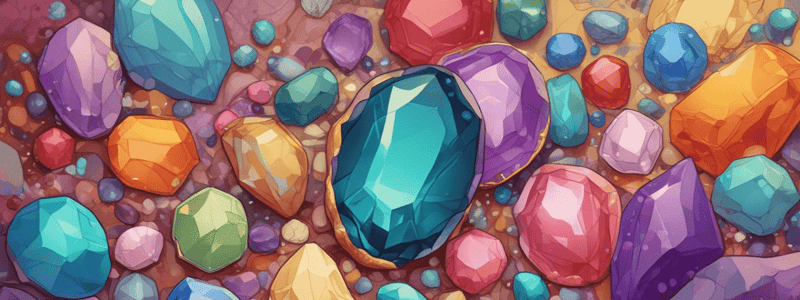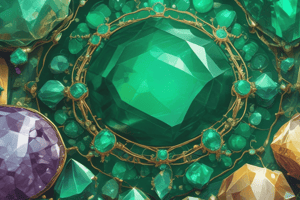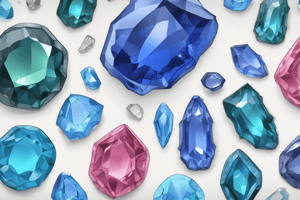Podcast
Questions and Answers
What is the most valuable type of topaz?
What is the most valuable type of topaz?
- Maxi Blue Topaz
- London Blue Topaz
- Imperial Topaz (correct)
- Sky Blue Topaz
What causes natural pink, red, and violet-to-purple colors in topaz?
What causes natural pink, red, and violet-to-purple colors in topaz?
- Chromium (correct)
- Iron
- Color centers
- Heat treatment
What is the result of heat and sunlight on topaz?
What is the result of heat and sunlight on topaz?
- Color enhancement
- Color fading (correct)
- Color change
- No effect
What is the most common color of topaz?
What is the most common color of topaz?
What is the term for blue topaz that has undergone heat treatment?
What is the term for blue topaz that has undergone heat treatment?
What is the main difference between blue topaz and other types of topaz?
What is the main difference between blue topaz and other types of topaz?
What is the origin of most topaz where they form in cavities?
What is the origin of most topaz where they form in cavities?
What is the reason for the color yellow in topaz?
What is the reason for the color yellow in topaz?
What is the rarest type of topaz?
What is the rarest type of topaz?
What affects the color of topaz?
What affects the color of topaz?
What is the primary method used to create or change the color of Topaz?
What is the primary method used to create or change the color of Topaz?
What is the desired result of heat treatment on yellow to reddish Topaz?
What is the desired result of heat treatment on yellow to reddish Topaz?
What is the purpose of coating Topaz?
What is the purpose of coating Topaz?
What combination of treatments is used to produce blue hues in Topaz?
What combination of treatments is used to produce blue hues in Topaz?
What is the risk of heat treatment on Topaz?
What is the risk of heat treatment on Topaz?
What is the purpose of irradiation on Greenish Yellow Beryl?
What is the purpose of irradiation on Greenish Yellow Beryl?
What is the result of heating yellow to reddish brown Topaz?
What is the result of heating yellow to reddish brown Topaz?
What is the purpose of heating purplish-to-bluish Topaz?
What is the purpose of heating purplish-to-bluish Topaz?
What is the purpose of coating certain Topaz?
What is the purpose of coating certain Topaz?
What is the term used to describe orange-to-yellow to brown topaz?
What is the term used to describe orange-to-yellow to brown topaz?
Which of the following is a common imitation material for aquamarine?
Which of the following is a common imitation material for aquamarine?
What is the term used to describe a violet-pink topaz from Pakistan?
What is the term used to describe a violet-pink topaz from Pakistan?
What is the name of the process used to create synthetic aquamarine?
What is the name of the process used to create synthetic aquamarine?
What is the term used to describe a pink topaz?
What is the term used to describe a pink topaz?
Which of the following is not a common imitation material for aquamarine?
Which of the following is not a common imitation material for aquamarine?
What is the term used to describe a yellow-to-orange topaz?
What is the term used to describe a yellow-to-orange topaz?
What is the characteristic of inclusions in Red Beryl?
What is the characteristic of inclusions in Red Beryl?
What is the synthetic process used to create aquamarine?
What is the synthetic process used to create aquamarine?
What is the typical cut of Yellow Beryl?
What is the typical cut of Yellow Beryl?
Which of the following is NOT a common imitation material for aquamarine?
Which of the following is NOT a common imitation material for aquamarine?
What is the term used to describe a yellow-to-orange to brown topaz?
What is the term used to describe a yellow-to-orange to brown topaz?
What is the typical size of a faceted Red Beryl?
What is the typical size of a faceted Red Beryl?
What treatment is used to improve the color of Yellow Beryl?
What treatment is used to improve the color of Yellow Beryl?
What is the purpose of fill fractures with colorless oils or synthetic resins in Red Beryl?
What is the purpose of fill fractures with colorless oils or synthetic resins in Red Beryl?
What is the result of heat treatment on bluish green or greenish yellow Aquamarine?
What is the result of heat treatment on bluish green or greenish yellow Aquamarine?
What is used to bring back the blue color of Maxixe Beryl if it has faded?
What is used to bring back the blue color of Maxixe Beryl if it has faded?
What is the purpose of heat treatment on greenish yellow Beryl?
What is the purpose of heat treatment on greenish yellow Beryl?
What treatment is used to eliminate the yellow or orange tint in Morganite (Pink Beryl)?
What treatment is used to eliminate the yellow or orange tint in Morganite (Pink Beryl)?
What is the primary cause of color variation in Topaz?
What is the primary cause of color variation in Topaz?
Which type of Beryl is known for its dark blue color that fades at different rates in the sunlight or heat?
Which type of Beryl is known for its dark blue color that fades at different rates in the sunlight or heat?
What is the primary reason for the use of heat treatment on Topaz?
What is the primary reason for the use of heat treatment on Topaz?
What is the term used to describe the pleochroism exhibited by Imperial Topaz?
What is the term used to describe the pleochroism exhibited by Imperial Topaz?
Which of the following is NOT a common color range for Aquamarine?
Which of the following is NOT a common color range for Aquamarine?
What is the primary cause of the color variation in Green Beryl?
What is the primary cause of the color variation in Green Beryl?
Which type of Beryl is known for its rich shades of yellow and gold?
Which type of Beryl is known for its rich shades of yellow and gold?
What is the primary difference between the color of Imperial Topaz and Red Beryl?
What is the primary difference between the color of Imperial Topaz and Red Beryl?
Flashcards are hidden until you start studying
Study Notes
Topaz
- Largest consumers of topaz are in Eastern Asia, USA, and Europe
- Preferred shades of topaz vary by region: pink and red in Eastern Asia, blue in the USA, and light yellow in Europe
- Imperial topaz is the most valuable, with a medium reddish orange to orange-red color
- Color range: commonly colorless, red, pink, purple, yellow, orange, brown, blue, and green
- Red and pink topaz varieties are rare and highly cherished
- Heat treatment is used to create or change color of topaz, but it's prone to breakage, clouding, and shattering
Aquamarine
- Largest market for aquamarine is China, followed by Japan, Europe, Germany, Italy, and the USA
- Color range: blue, very slightly greenish blue, greenish blue, very strongly greenish blue, or green-blue
- Finest color is moderately strong medium-dark blue to slightly greenish blue
- Heat treatment is used to remove yellow and produce pure blue colors
- Most aquamarine is heat-treated to enhance color
Morganite (Pink Beryl)
- Largest market for morganite is China and the USA
- Color range: pink, rose, peach, and salmon
- Trace elements of manganese are present
- Found in pegmatite rocks
Red Beryl (Bixbite)
- Rare and valuable with a raspberry red, purplish red to orange-red hue
- Found in the Wah Wah Mountains in Utah, USA
- Has inclusions of fingerprint, two-phase, and solid crystal inclusions, distinct color zoning, and growth features
Yellow/Golden Beryl
- Rich shades of yellow and gold, sometimes with an orange or greenish tint
- Found in pegmatite rocks in Brazil, Namibia, and Sri Lanka
Sources of Beryl and Topaz
- Afghanistan, Mozambique, Namibia, and the US are minor and inconsistent sources of Red Beryl.
- Wah Wah Mountains in Utah, US, are a source of Red Beryl, but the mine closed in the early 2000s.
- Yellow Beryl is found in Minas Gerais, Brazil, as well as in Namibia, Madagascar, and Sri Lanka.
- Green Beryl is found in Brazil, Zimbabwe, and Australia.
Characteristics of Cuts
- Topaz is often cut into oval, pears, and emerald shapes due to its elongated crystal structure.
- Aquamarine is often cut into emerald or round brilliants, and sometimes fancy cuts and ornamental shapes.
- Red Beryl is often cut into melee sizes, with an average faceted weight of 0.15 ct, and 1 ct is considered rare.
- Yellow Beryl is typically cut into emerald shapes and placed in rings, brooches, pendants, or earrings.
Clarity Characteristics
- Aquamarine is often eye-clean, but may have liquid inclusions.
- Red Beryl may have fingerprint and two-phase inclusions, unhealed fractures, solid crystal inclusions, distinct color zoning, and growth features.
- Yellow Beryl is typically eye-clean.
Synthetic Processes
- Aquamarine is often synthesized using hydrothermal methods in Russia.
- Morganite (Pink Beryl) is synthesized using hydrothermal methods in Russia.
Common Imitation Materials
- Aquamarine is often imitated by treated blue topaz, pale blue glass, and synthetic blue spinel colored by cobalt.
- Maxixe Beryl is irradiated aquamarine.
Trade Names
- "Rose Topaz" is a term used for pink topaz.
- "Sherry Topaz" is orange-to-yellow to brown topaz, sometimes called "precious topaz".
- "Cyclamen pink" is a violet-pink topaz from Pakistan.
- Red Beryl is also known as "red emerald", "bixbite", and "raspberry red".
- Yellow/Golden Beryl is also known as "heliodor".
Cutting and Trading Centers
- Topaz mined in Brazil is cut in Brazil, while other important cutting centers are in Germany, Thailand, and China.
- Aquamarine is cut in Idar-Oberstein, Germany.
- Morganite (Pink Beryl) is cut in Shenzhen, China, and Jaipur, India.
Geological Origins
- Aquamarine grows in pegmatites, and alluvial deposits yield most material.
- Morganite (Pink Beryl) contains trace elements of manganese and is found in pegmatites.
- Red Beryl contains trace elements of manganese and is found in fissures of rhyolite.
- Yellow Beryl contains trace elements of iron.
Crystal Structure
- Topaz has an orthorhombic crystal system, typically elongated with strong parallel grooves, and has basal cleavage issues.
- Aquamarine has a six-sided columnar crystal structure with flat faces at its ends.
Possible Phenomena
- Aquamarine exhibits pleochroism, showing near-colorless and strong blue in different crystal directions.
- Morganite (Pink Beryl) exhibits distinct pleochroism, showing pale pink and a deeper violetish pink.
- Red Beryl exhibits pleochroic shades of purplish red to red to orangy red.
Studying That Suits You
Use AI to generate personalized quizzes and flashcards to suit your learning preferences.




